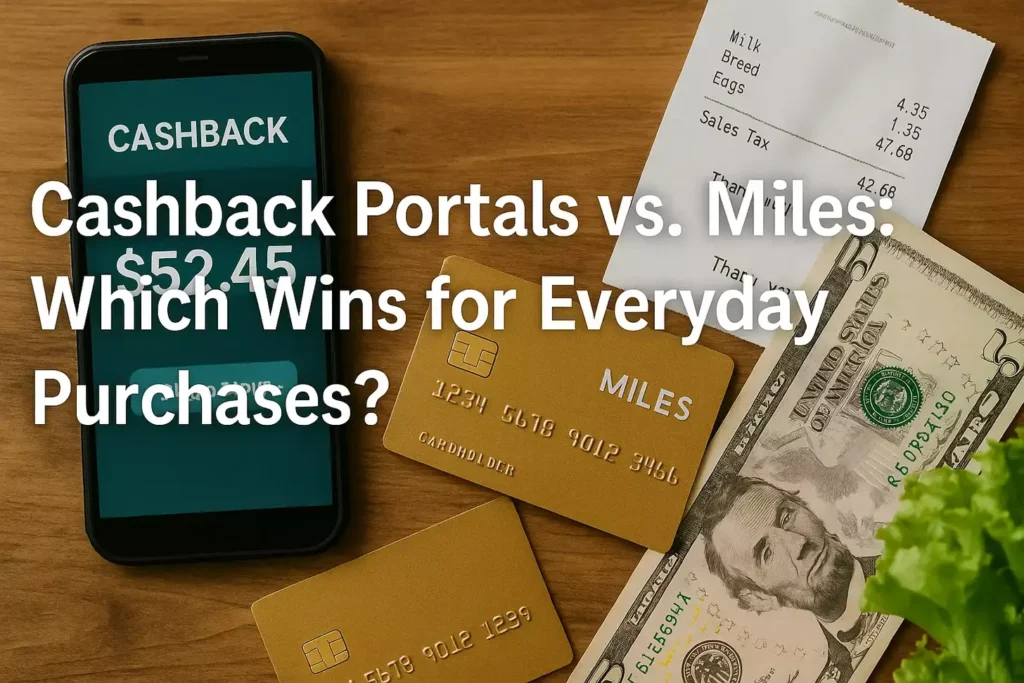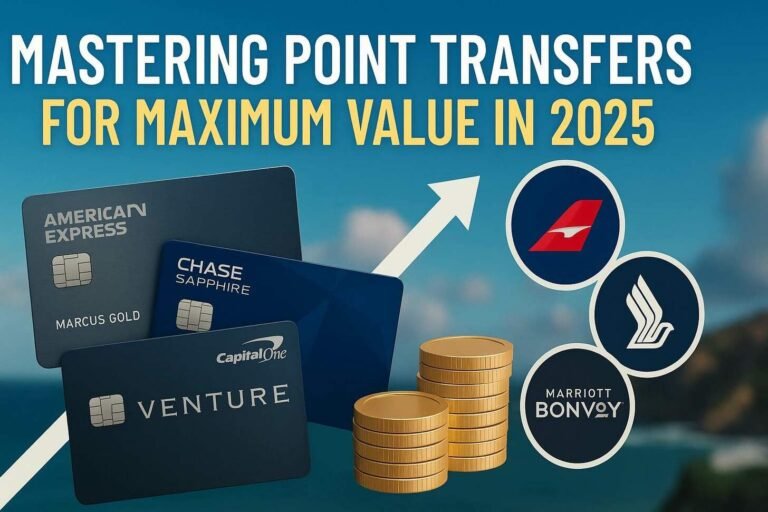Affiliate Disclosure: Award Travel Hub may earn a commission or referral bonus from some links on this site. These affiliate links help support our work and may influence the placement or promotion of certain products or services. However, our content is independently crafted to reflect honest opinions. Not all offers or products are included. There is no additional cost to users when they utilize our affiliate links.
Did you know the average household could earn over $750 annually just by choosing the right rewards strategy? That’s a significant return on your regular spending. We’re tackling one of the biggest questions in personal finance today.
When you use a rewards credit card, you typically choose between two paths. One offers immediate, tangible returns on your purchases. The other focuses on building value for future adventures. Neither path is inherently better. They are simply different strategies for maximizing value.
This guide will break down the core differences for you. We’ll explore how each rewards structure operates in the real world. Our analysis looks at redemption values, flexibility, and how to match a strategy to your lifestyle.
By the end, you will have a clear framework. This will help you decide which approach aligns with your financial goals and travel rewards aspirations. Let’s find the best way to make your spending work for you.
Key Takeaways
- There are two main reward types: immediate returns and future travel value.
- The best choice depends entirely on your personal spending habits and goals.
- Understanding redemption options is crucial for maximizing your earnings.
- Flexibility and ease of use are essential factors to consider.
- A well-chosen strategy can add hundreds of dollars in value each year.
- Your lifestyle and travel ambitions should guide your decision.
Introduction: Setting the Stage for Everyday Rewards
Your daily spending habits hold a hidden key to unlocking significant financial benefits through strategic credit card use. Groceries, gas, and other routine expenses represent a powerful stream of potential value.
We understand that the sheer number of rewards cards can be overwhelming. It’s easy to feel lost when every bank offers a different deal.

This guide is designed to cut through the complexity. We break down sophisticated rewards structures into clear, actionable insights you can use immediately.
Rewards programs have evolved into powerful financial tools. When used with intention, they deliver real value on spending you’re already doing.
Our mission is to provide transparent guidance. We help you maximize returns, whether you prefer simple savings or aspirational experiences.
Understanding the core differences between reward types is crucial. It allows you to build a strategy that truly serves your lifestyle.
| Reward Focus | Best For | Key Consideration |
|---|---|---|
| Immediate Value | Budget-conscious individuals | Direct savings on statements |
| Future Travel | Frequent travelers | Requires planning for maximum benefit |
The right approach depends entirely on your goals. We equip you with the knowledge to make the best choice for your situation.
Understanding Cashback Portals
The appeal of direct financial returns makes percentage-back programs a popular choice for practical budgeters. These systems provide straightforward value without complex calculations.

Definition and Key Concepts
Percentage-back credit cards provide a simple rewards structure. You earn a fixed percentage of your spending back in cash. This can appear as statement credits, bank deposits, or checks.
Different cards offer varying structures. Flat-rate options provide consistent returns on every purchase. Tiered systems reward specific spending categories with higher percentages.
“The beauty of percentage-back programs lies in their transparency—what you see is what you get.”
How Cashback Portals Work for Daily Spending
These programs integrate seamlessly into routine expenses. Groceries, utilities, and gas purchases become opportunities for savings. The process is automatic once you activate your rewards credit card.
Redemption is flexible and user-friendly. Most programs allow withdrawals in any amount. Rewards typically don’t expire as long as your account remains active.
| Card Type | Best For | Earning Structure |
|---|---|---|
| Flat-Rate | Simplicity seekers | Same percentage on all spending |
| Tiered | Category optimizers | Higher rates on specific purchases |
| Rotating | Active managers | Quarterly changing categories |
Each approach serves different financial personalities. The right choice depends on your spending patterns and management preferences.
The Mechanics of Miles Credit Cards
Many travelers overlook the power of converting daily expenses into valuable travel currency. These specialized financial tools transform routine spending into future adventures. Understanding how they work can unlock incredible value.
Earning Miles with Every Purchase
Every dollar you spend accumulates points that build toward your next journey. Most programs offer one point per dollar on general purchases. Travel-related spending often earns accelerated rates.
There are three main types of these financial products – branded airline cards that partner with specific carriers. Hotel cards focus on accommodation benefits. Transferable points cards offer maximum flexibility across multiple loyalty programs.
Redeeming Miles for Travel and Beyond
The real magic happens when you redeem accumulated points. Value varies significantly based on how you use them. Strategic redemptions can yield exceptional returns.
Economy flights might offer modest value. Premium cabin redemptions often deliver outstanding returns. Some programs extend beyond flights to include hotel stays and unique experiences.
Welcome bonuses provide substantial initial value. Meeting spending requirements can fund entire trips. This makes the first year particularly rewarding for new cardholders.
Flexibility is key when planning redemptions. Award availability and transfer partners require research. The effort pays off through premium travel experiences.
Daily Spending: How Rewards Impact Every Purchase
Your routine expenses are more than just costs – they’re opportunities to build value with each transaction. We believe in making your money work smarter, not harder.
Tracking Your Spending for Maximum Benefits
Understanding your monthly spending patterns is the foundation of rewards optimization. Most people spend consistently in key categories like groceries, gas, and dining. Tracking reveals where your money actually goes.
Many rewards cards have specific requirements that impact your earnings. Some only unlock higher rates after you reach a spending threshold each billing cycle. Others cap the amount that qualifies for elevated rewards.
Consider these common spending categories:
- Groceries: $400-600 monthly
- Gas: $150-250 monthly
- Dining: $200-400 monthly
- Utilities and subscriptions: $150-300 monthly
For travel rewards enthusiasts, consistent spending efficiently accumulates points. Spending $2,000 per month on a 2x-earning card earns 48,000 points annually. This could cover significant travel expenses.
The key is strategic routing of existing purchases. Use budgeting tools to monitor which card each transaction is charged to. This ensures maximum return on every purchase without changing your lifestyle.
“Rewards optimization isn’t about spending more – it’s about spending smarter with the money you already allocate.”
Remember that some cards revert to lower rates after hitting category caps. Being aware of these limits helps you plan your spending strategy effectively across multiple rewards cards.
Comparing Rewards: Benefits of Cashback and Miles
At the heart of the rewards debate lies a clear distinction: instant gratification versus long-term value. This fundamental trade-off shapes every aspect of how you earn and use your benefits.
We believe the best choice depends on your personal goals and how you prefer to engage with your finances.
Immediate Savings vs. Future Travel Perks
Programs offering direct returns provide simplicity and certainty. Your earnings are straightforward and can be used for anything, from bills to gifts. This universality is a major strength.
In contrast, points-based systems connected to airline or hotel brands offer a different kind of value. They open doors to premium experiences, like luxury hotel stays or first-class flights. The potential return can be significantly higher for dedicated travelers.
“The value of travel points truly shines when redeemed for premium experiences that would otherwise be cost-prohibitive.”
Flexibility in Redemption Options
Flexibility is another critical differentiator. Direct monetary returns are incredibly versatile. You face no blackout dates or complex rules.
Many top-tier travel rewards cards bundle valuable perks beyond points. These can include lounge access and insurance. However, maximizing these rewards credit programs often requires more active management and planning.
Different cards offer varying levels of flexibility. The right credit cards for you will align with your desire for simplicity or your willingness to plan for outsized value.
Evaluating Fee Structures and Spending Requirements
The true value of any rewards program isn’t just in what you earn, but in what you keep after costs. We believe in looking beyond the headline rewards rate to understand the full financial picture.
Understanding Annual Fees and Hidden Costs is essential. Some premium rewards credit cards come with significant annual fees. These costs must be weighed against the benefits you’ll actually use.
Many excellent no-fee credit cards exist. They provide immediate value without requiring a break-even calculation. This makes them a fantastic starting point for many people.
Premium travel credit cards often justify their cost with valuable perks. These can include annual statement credits, lounge access, and bonus points. For frequent travelers, these benefits can easily surpass the annual fee.
“Always calculate your net value: rewards earned minus all fees equals your true benefit.”
Be mindful of other potential charges. Foreign transaction fees can quickly erode rewards on international purchases. We always recommend choosing cards with no foreign transaction fees if you shop abroad.
Your credit score also plays a role. Premium cards typically require excellent credit. Many cash-back cards are more accessible to those with good credit.
The key is to match the card to your spending patterns and lifestyle. Don’t pay for benefits you won’t use. Calculate your expected annual rewards, subtract fees, and choose the option that offers you the highest net value.
Real-Life Examples and Usage Scenarios
Let’s see how these strategies translate into real-world value for different types of spenders. We believe concrete examples provide the clearest picture for making your own choice.
Case Studies from Everyday Consumers
Consider a teacher with a focused monthly spending plan. She uses a tiered rewards credit card for groceries and gas. This approach yields significant, immediate savings on her essential bills.
Now, contrast this with a consultant who travels frequently for work. His spending is broader, covering flights, hotels, and meals. A travel rewards card that earns multiple points per dollar is ideal for him.
| Consumer Profile | Optimal Strategy | Annual Value |
|---|---|---|
| Teacher (Category Spender) | Tiered Cashback Card | $720+ in direct savings |
| Consultant (Broad Spender) | Travel Rewards Card | 60,000+ miles for flights |
Comparative Analysis of Purchase Categories
Some cards offer particularly high returns on specific categories. Grocery spending is a prime example. A high cashback rate here can outperform a standard miles-earning credit card.
Conversely, dining and travel expenses often unlock bonus earnings with premium credit cards. This is where a travel rewards strategy truly shines. The potential value per point can increase dramatically.
The key insight is clear. Immediate savings work best for consistent category spending. Future travel value excels for those who spend broadly and redeem strategically for premium experiences.
Expert Insights on Maximizing Credit Card Rewards
True rewards mastery goes beyond simply selecting the right card—it’s about orchestrating a comprehensive system that optimizes every transaction. We’ve developed a framework that transforms your spending into a coordinated strategy.
Tips for Strategic Spending
The multi-card approach delivers superior results. Use different rewards cards for specific spending categories. This coordination can boost your annual earnings by 30-50% compared to using a single card.
Automation is your secret weapon. Set recurring bills on specific credit cards to never miss earning opportunities. Enable autopay to avoid interest charges that would negate your rewards value.
We recommend using reward calculators or building a simple spreadsheet. Enter your monthly spending by category to identify which combination of travel cards and cash-back options delivers the highest returns.
Strategic timing matters significantly. Make large purchases during welcome bonus periods to hit spending thresholds. Concentrate spending in rotating bonus categories during their active quarters.
Always pay your full statement balance before the due date. Carrying a balance at a typical 18-25% APR will instantly erase months of rewards credit earnings. The goal is to optimize the spending you’re already doing.
This systematic approach ensures every dollar works harder for you. It transforms routine expenses into strategic opportunities for maximum value.
Emerging Trends in Travel Rewards and Cashback Portals
Looking ahead, the world of consumer rewards is set for exciting changes that will benefit savvy users. We’re tracking significant evolution in how programs operate and deliver value.
What the Future Holds for Rewards Programs
Digital integration is transforming rewards. More credit cards now offer instant mobile redemption and real-time notifications. AI-powered suggestions help choose the best card for each purchase.
Flexibility continues to accelerate across programs. Many travel rewards cards now provide hybrid redemption choices. Points can be used for premium travel or converted to statement credits.
Sustainability-focused rewards are gaining traction. Some programs offer bonus points for eco-friendly purchases. This appeals to environmentally conscious consumers.
Category expansion reflects modern spending habits. Beyond traditional categories, newer cards reward streaming services and home improvement. This matches how people actually spend today.
The competitive landscape keeps intensifying. Banks regularly enhance benefits to attract customers. This trend benefits consumers who stay informed about their options.
“The future of rewards lies in personalized, flexible experiences that adapt to individual lifestyles and values.”
Premium travel rewards programs now often include subscription bundling. These added perks can provide substantial annual value beyond traditional benefits.
Cashback Portals vs. Miles: Which Wins for Everyday Purchases?
No single rewards formula fits everyone – your personal circumstances dictate which path delivers maximum value. We believe the optimal choice emerges from honest self-assessment rather than following generic advice.
Immediate returns work best when you prioritize simplicity and guaranteed savings. This approach suits those who rarely travel or prefer straightforward financial benefits. The right credit card for this strategy offers universal redemption options.
Travel-focused credit cards excel for frequent flyers who enjoy planning premium experiences. These travel cards reward research and strategic redemption with exceptional value. They transform routine spending into luxury adventures.
Many consumers find success with a hybrid approach. They use different rewards cards for specific spending categories. This balances immediate savings with future travel funding.
High-spending households often benefit more from travel-oriented credit cards. The math favors points accumulation when monthly expenses exceed $3,000. The right type of card depends entirely on your redemption habits.
Ultimately, trust your instincts about what feels sustainable. Your lifestyle preferences should guide this important financial decision.
Conclusion
Making the final choice between reward paths becomes clear when you trust your own spending insights. No one understands your financial habits better than you. We have provided data-driven insights to support informed decision-making.
Remember this fundamental truth. Both travel rewards credit cards and straightforward options deliver substantial value. The right type of card aligns perfectly with your lifestyle and goals.
One path offers simplicity and guaranteed returns on every purchase. The other unlocks premium experiences, such as luxury hotel stays and priority boarding. Your personal preferences are the ultimate guide.
We encourage you to audit your spending. Calculate potential earnings from different credit cards. Choose the strategy that feels most sustainable for your journey.
Your decision is a powerful step toward maximizing your financial potential. Use your new knowledge with confidence.






